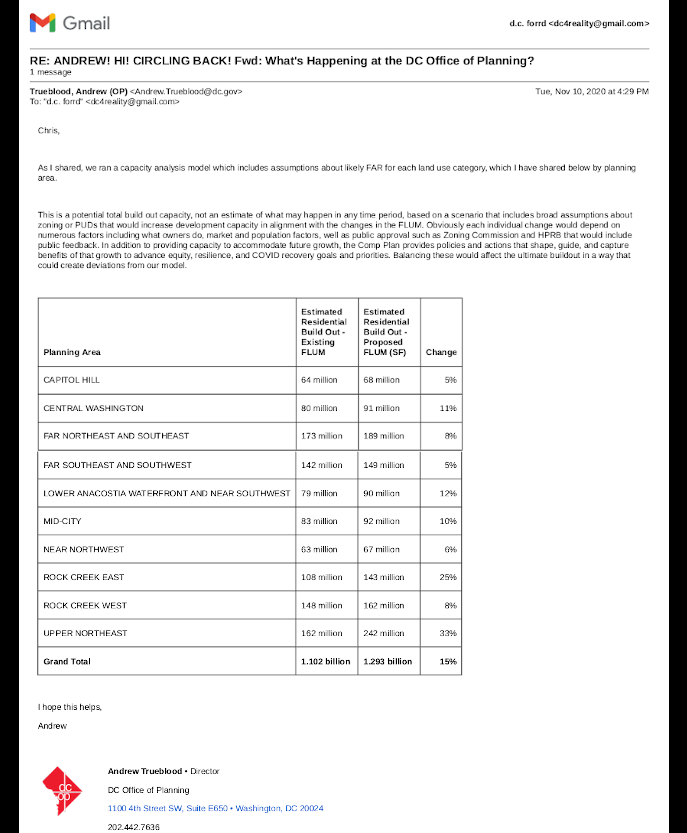During the pandemic in 2022, GGW’s Libby Solomon covered how DC’s “affordability” index is based on the DMV’s ever increasing Area Median Income (“AMI”). See here: https://ggwash.org/view/81935/here-are-dcs-new-affordable-housing-income-limits-for-2021
However, what GGW consistently forgets to do is make some solid conclusions that may help the people struggling to stay in their hometown of DC. For example, using Ms. Solomon’s insights and links in her post above combined with the data points below (all cited and sourced to original DC government reports), we conclude:
DC’S AFFORDABILITY POLICY IS BROKEN
- Any “affordability” policy in DC that relies on the annually increasing Area Median Income (“AMI”) or functional equivalent Median Family Income (“MFI”) is broken;
- The policy and results become more and more broken as wealthy residents in the region become wealthier and as the DMV welcomes more and more new wealthy people.
- As the AMI continues to trend upwards, DC becomes less affordable and gentrification increases. This means the growing displacement of lower income residents which pushes up the AMI even faster fueling even more gentrification.
Looking at the AMI Numbers — DC’s affordability is becoming less and less affordable as the AMI increases annually
See the following data points over time:
Year; AMI
2011; 106,100
2013; 107,300
2015; 108,600
2018; 117,200
2020; 126,000
2021; 129,000
2022; 142,300
2023; 152,100
Conclusion:
Between 2013 to 2023, the AMI has increased $44,800, a 42.2% increase over ten years. This means the available pool of “affordable” units becomes less and less accessible by those who need it most as wealthier DC residents (those making more than two to three times the minimum wage) can qualify for DC’s limited supply of so-called “affordable” housing units.
The U.S. Census numbers show the results: A substantial number of lower income families and residents have been displaced from the city (60,000 Black residents over the past two decades) under DC’s current broken “affordability” policy based on the ever increasing “AMI.”
Ward One leads in Black displacement, with 25% of the Black population made gone over the past ten years as the AMI is really just starting to soar.
AMI Sources:
- 2011 — The Washington, DC area median income as determined by HUD for fiscal year 2011 is to equal $106,100. https://dhcd.dc.gov/sites/default/files/dc/sites/dhcd/publication/attachments/FY%202011%20DHCD%20Program%20Income%20and%20Rent%20Limits.pdf
- 2013 — The Washington, DC area median income, as determined by HUD for FY2013, is $107,300. https://dmv.dc.gov/sites/default/files/dc/sites/dhcd/publication/attachments/2013%20DHCD%20Rent%20and%20Income%20Limits.pdf
- 2015 — Maximum household income limits are based on the Washington Metropolitan Statistical Area 2015 Area Median Income (AMI) of $108,600 for a household of four, as published by the U.S. Department of Housing and Urban Development (HUD) on March 31, 2016. https://dhcd.dc.gov/sites/default/files/dc/sites/dhcd/publication/attachments/IZ%20Income%20Limits%202016.pdf
- 2018 — In FY2018, Median Family Income (MFI) for the Washington, D.C. metropolitan statistical area, as published annually by the U.S. Department of Housing and Urban Development (HUD), for a family of four was $117,200, and is adjusted for household size. https://dhcd.dc.gov/sites/default/files/dc/sites/dhcd/page_content/attachments/FY%202018%20Inclusionary%20Zoning%20Annual%20Report_0.pdf
- 2020 — The MFI for a household of 4, as published by the U.S. Department of Housing and Urban Development (HUD) on April 1, 2020, is $126,000. The limits are adjusted for household size in this schedule. https://dhcd.dc.gov/sites/default/files/dc/sites/dhcd/publication/attachments/2020.7.17%20IZ-ADU%202020%20Price%20Schedule.pdf
- 2021 — DC’s MFI in 2021 is $129,000 for a household of four. https://ggwash.org/view/81935/here-are-dcs-new-affordable-housing-income-limits-for-2021
- 2022 — Maximum Household Income Limits, rents and purchase prices are based on the Washington Metropolitan Statistical Area 2022 Median Family Income (MFI), previously referred to as Area Median Income (AMI), of $142,300 for a household of four, as published by the U.S. Department of Housing and Urban Development (HUD) on April 18, 2022. https://dhcd.dc.gov/publication/2022-2023-inclusionary-zoning-maximum-income-rent-and-purchase-price-schedule
- 2023 — Maximum Household Income Limits, rents and purchase prices are based on the Washington Metropolitan Statistical Area 2023 Median Family Income (MFI), previously referred to as Area Median Income (AMI), of $152,100 for a household of four, as published by the U.S. Department of Housing and Urban Development (HUD) on May 15, 2023. https://dhcd.dc.gov/publication/2023-2024-inclusionary-zoning-maximum-income-rent-and-purchase-price-schedule



